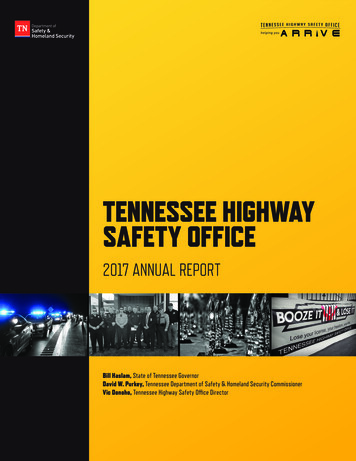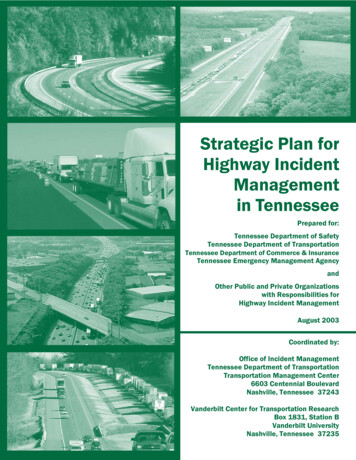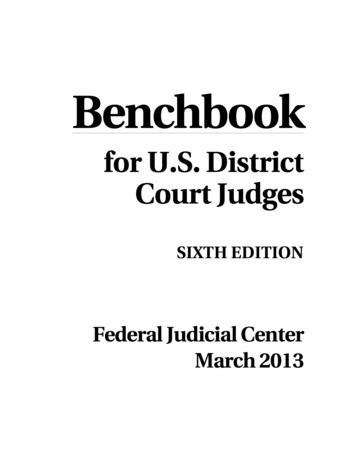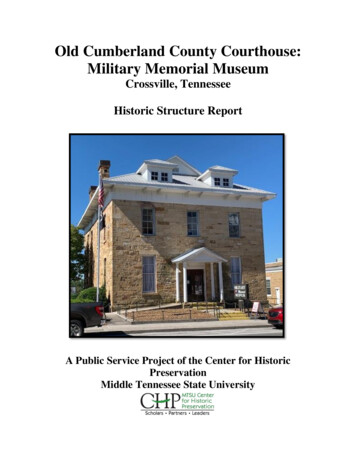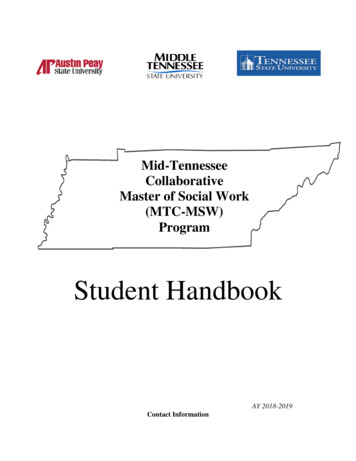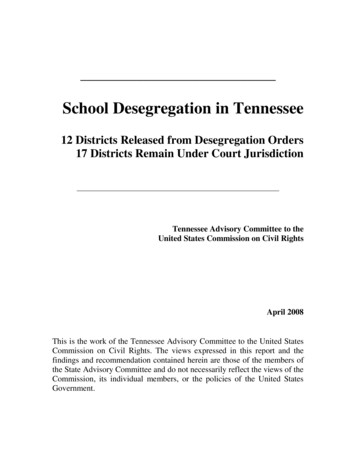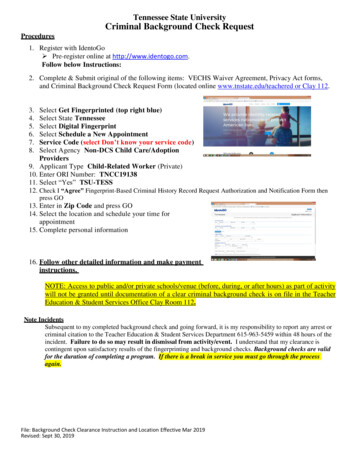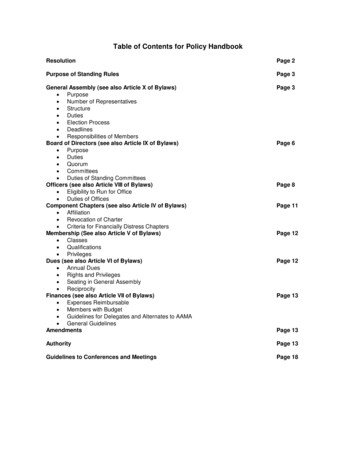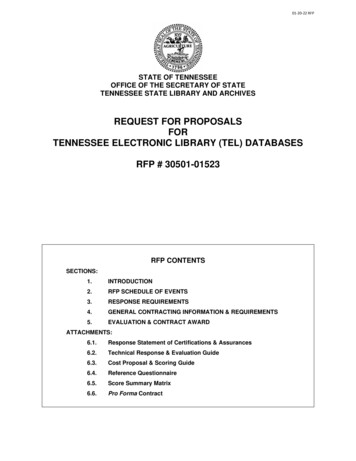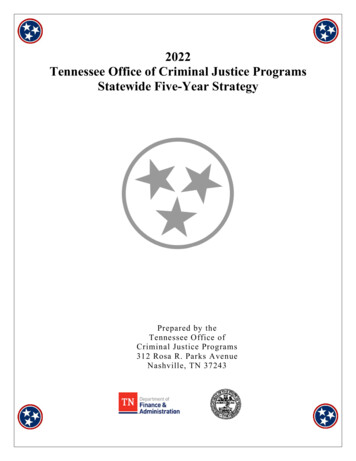
Transcription
2022Tennessee Office of Criminal Justice ProgramsStatewide Five-Year StrategyPrepared by theTennessee Office ofCriminal Justice Programs312 Rosa R. Parks AvenueNashville, TN 37243
Table of ContentsChapter 1. Executive Summary3Chapter 2. Introduction5Chapter 3. Strategic Planning Process6Chapter 4. Data and Data Analysis14Chapter 5. Tennessee’s Strategies for Addressing Needs and Gaps23Appendices:Appendix A: Tennessee’s Strategic Process for Planning & Managementand Evaluation StrategyAppendix B: An Overview of the Criminal Justice System in Tennessee2
Executive SummaryThe Tennessee Office of Criminal Justice Programs (OCJP) manages a systematic, yearround cycle for tracking problems surfacing in the criminal justice system, monitoring trendsin Tennessee’s communities, assessing the condition of the state’s resources, setting programpriorities, making grant allocation decisions, managing those grant funded projects, measuring performance, and evaluating the results of those decisions. Our strategic programmanagement process looks several years ahead of daily grants management activities towardthe changing needs of Tennessee’s justice system. The process helps OCJP focus its futureprogram descriptions, set its funding priorities, prepare its budget requests, and direct its limited resources to areas that promise the best return for the public’s investment.As in most states, the majority of Tennessee’s criminal justice dollars continue to be raised fromlocal taxes and spent on local and state criminal justice priorities and problems. Crimes are committed locally, and that is where offenders are apprehended, defendants are tried, sentences aredetermined and carried out, and where services are provided to the victims of crime and to offenders. The Statewide Multi-Year Strategy serves as the blueprint for all coordinated drug and violent crime control efforts in the state, the rehabilitative services for those that commit thosecrimes, and the reparative services for those victimized. Therefore, it is imperative that the stateutilize a strategic planning process that reflects the diverse perspectives of practitioners and be asinclusive as possible. To that end, the Office of Criminal Justice Programs (OCJP) takes a datadriven approach and proactively seeks input from practitioners on the local, state, and federal levels to assist in influencing the strategy. OCJP gathers practitioner information through a variety ofplanned information gatherings, training conferences, and webinars, as well as through informalmeetings and surveys. This strategy document is a reflection of this information gathered fromacross the state as well as data from across the nation.This document will do the following: provide an introduction to the Office of Criminal JusticePrograms and the state of Tennessee as a whole, outline the strategic planning process conductedby OCJP, review the current data related to crime, victimization, and services, identify the areas ofgreatest need tied to systemic weakness, and outline the plan moving forward to address thoseneeds. The appendices provide an in-depth look at OCJP’s robust strategic planning process andevaluation management style and Tennessee’s criminal justice system.This report will demonstrate that the data suggests the following six areas of need: Continued focus on domestic violence and sexual assault to continue the positivesteps gained in the last plan and enhance progress in these areas Sustained use of a coordinated approach to apprehension and prosecution of drug offenses and violent crimes Data-driven, location-based strategies to crime reduction and addressing trauma Meeting basic infrastructure issues such as technology and equipment enhancements,criminal justice and victim service practitioners’ training related to evidence basedbest practices and policies, and advancing access to data across the continuum Continued enhancement of trauma informed victim services, focusing on best practices and reaching unserved and underserved victims Incorporating systemic changes as a result of responding to the COVID pandemic andongoing adjustments to the field to prevent, mitigate, and respond to the virus3
As OCJP formulated this plan; there were many unprecedented events that influenced the work ofthis office looking forward. The impact of the pandemic on the criminal justice system and victimservices, and the manner by which procedures and services are provided, will likely result in sustained changes to how these entities conduct business on a day-to-day basis. The mass violenceincident on December 25, 2020 was of such magnitude that Tennessee may receive additionalfunding through various sources to assist the victims, first responders, and community to heal andrepair. Finally, with the federal budget’s expansion of state allocations of VOCA funding fromthe victims of crime fund culminating with the 2018 award and then contracting to approximatelyone-third of that amount within three years, this plan and Tennessee will see funding for victimservices at the height of this federal funding roller coaster at the beginning of the plan and slowingto an austerity budget towards the end of this plan.OCJP is excited about the opportunities this plan provides to address crime in Tennessee over thenext five years. OCJP will continue to seek information and input from our local and state levelpeers to enhance our understanding of the current needs and issues Tennessee faces over thecourse of this multi-year plan. Each year, specific strategies will be developed to address the mostpressing issues.4
IntroductionThe Office of Criminal Justice Programs (OCJP), which is located within the Tennessee Department of Finance and Administration, continues to serve as the State AdministrativeAgency for several federal government funding agencies for Tennessee including, but notlimited to, the Edward Byrne Justice Assistance Grant (JAG) Program, Victims of Crime Act(VOCA) Program, Office of Violence Against Women (OVW) Program, Family ViolencePrevention and Services Act (FVPSA) Program, Sexual Assault Services Program (SASP),National Criminal History Improvement Program (NCHIP), the NICS Record Act Improvement Program (NARIP), Project Safe Neighborhood (PSN), and the Paul Coverdell ForensicScience Improvement Program (Coverdell). For two decades, these programs have provideda vehicle for seeding and pioneering new projects as well as sustaining victim services acrossthe state. This federal funding is complemented by various state fees, fines, and appropriations that further the initiatives of this office.Tennessee’s implementation of these programs continues to evolve along with its criminaljustice system. The funding programs assist OCJP in stimulating evidence-based projectsthat are multi-faceted responses to crime and victimization in our state even as it supports ourimprovement of the infrastructure of the state’s criminal justice system. With this Multi-YearStatewide Strategy, the state of Tennessee continues its commitment to reduce the incidenceof drug use, drug trafficking, and violent crime within the state’s boundaries while workingto increase victim safety and reduce the impact of crime on victims.At the close of the previous five-year plan, the Office of Criminal Justice Programs was at anall time high for the amount of obligations and number of subrecipients. From 2017 throughthe start of state fiscal year 2021, OCJP increased the number of agencies receiving fundingfrom 194 to 304, and the number of contracts from 300 to 572. In 2021, OCJP was chargedwith the oversight of fifteen 2020 federal awards and sixteen state funding streams with theanticipation of another new state fund source in fiscal year 2022. At the beginning of statefiscal year 2021, OCJP obligated over 8 million dollars in state funding and over 74 million in federal funding. This was an increase of almost 150% from state fiscal year 2017. Inthe same time period, the monitoring reports more than doubled. OCJP anticipates this current trend in the amount of obligations, number of contracts and number of monitoring reports to continue at the FY 2021 level through state fiscal year 2022 and into the start of statefiscal year 2023, at which point the VOCA reductions will be implemented and the trendswill move back towards 2017 levels.In an effort of continuous improvement, updates have been made to the structure of the FiveYear Strategic Plan. The Strategic Planning Process and Evaluation Management Strategy(Appendix A) and well as the Overview of the Criminal Justice System in Tennessee(Appendix B) have been enhanced and added as appendices to the plan. The following chapters will provide an overview of the day-to-day and annual structure of OCJP strategic planning, provide the recent data that has informed this multi-year strategic plan; and outline thegoals, strategies, outputs, and outcomes of the plan. It is anticipated that OCJP will continueto provide an Annual Report highlighting the work of the past year as well as an annual addendum to this strategic plan document, as has been the standard for the past five years. It isanticipated that the output and outcome sections will be enhanced through the future addendaas this is an area of improvement for OCJP.5
Strategic Planning ProcessThe Tennessee Office of Criminal Justice Programs (OCJP) manages a systematic, yearround cycle for determining communities’ needs, identifying the justice system’s problems,setting program priorities, making grant allocation decisions, managing those funded projects, and evaluating the results of those decisions. Strategic program management is a structured process that looks three to five years ahead of daily grants management activitiestoward the changing needs of Tennessee’s justice system. OCJP tracks problems surfacing inthe criminal justice system, monitors trends in Tennessee’s communities, assesses the condition of the state’s resources, and measures the recent performance of OCJP-funded programs.All of this information helps OCJP focus its future program descriptions, set its funding priorities, prepare its budget requests, and direct its limited resources to areas that promise thebest return for the public’s investment. The process described in this chapter is a simplifiedversion taken from Appendix A.In January 2019, Governor Bill Lee became the 50th Governor of Tennessee. Governor Leesigned Executive Order 6, Establishing the Tennessee Criminal Justice Investment TaskForce (CJITF). The Task Force released its first set of recommendations in December of2019, which have influenced OCJP’s strategic planning. Some of the initial data that guidedthe work of the Taskforce came from the most recent decade of data included the following: A dramatic increase in the length of time spent incarcerated; An overreliance on incarceration for non-violent individuals and technical violatorsof community supervision; A stark increase in the number of women in prison; A steady growth in the mental health caseloads at TDOC facilities; and A deficit of treatment and re-entry supports necessary for individuals to succeedwhen returning to their community from a custodial sentence.The CJITF resulted in a total of 23 policy recommendations to reduce recidivism and improve public safety, with the goals of: Strengthening responses to individuals with behavioral health needs; Ensuring equal opportunities to state individuals housed in local jails; Focusing state resources on violent and high-risk individuals; Improving the efficiency and effectiveness of community supervision; Minimizing barriers to successful re-entry; and Ensuring the sustainability of criminal justice reforms.This administration further recognized the importance of the voices of crime victims, survivors, and those community-based organizations that serve this population and other local,state, and federal criminal justice officials. There were three forums held in the fall of 2019,one in each of the grand divisions across Tennessee. The Forums were led by Anne Seymour, Consultant with the Crime and Justice Institute (CJI). The Taskforce’s initial findingsthat guided the discussions in the forums (per a summary memorandum from Anne Seymour) included the following: Tennessee's prison population has grown 12% over the last decade, impacted by a23% increase in time served by felony offenders and a 28% decline in parole releases.6
Non-person offenses accounted for 74% of Tennessee's admissions to prison in FY2018, including drug or property crimes.Approximately 5,000 admissions to prison in FY 2018 were the result of a parole orprobation revocation, with over 50% of revocations in FY 2019 resulting from atechnical violation or failed drug test.The number of offenders held in custody in state prison with mental health issues increased 26% from FY 2016 to FY 2019.The female prison population has grown 47% in the last decade, with 41% of the incarcerated female population serving in local jails where there are fewer treatmentand programming opportunities.The following priorities identified in the forums aligned directly with OCJP’s strategic planning (cited in the memorandum dated December 19, 2019 from Anne Seymour): Every courthouse across the state should have designated safe rooms for victims, survivors, and their families to use during trials. Expanded services and support are needed to protect children in domestic violencesituations and to prevent re-traumatization when an offender returns home and continues the cycle of violence. Post-conviction victim advocates who can coordinate with court-based and community-based victim advocates are needed to guide victims and survivors through the parole, reentry and community supervision processes, and offer survivor-centered reentry safety planning. Comprehensive programming that is gender-responsive and trauma-informed is needed to help justice-involved women while incarcerated, and in wrap-around servicesupon their return to the community. Improved oversight and expansion of Batterers Intervention Programs are needed toassess their overall effectiveness and any need for improvement. The unique needs of victims/survivors and offenders in rural communities should berecognized and addressed by collaborative efforts involving the community and thejustice system.OCJP’s Strategic Planning PartnersTennessee OCJP has developed a sophisticated ongoing process for involving state and local officials as well as local practitioners in criminal justice planning. The problems and needs OCJPgathers from these and other sources are translated into priorities for action, which are later linkedto one or more of Tennessee’s grant program areas. OCJP has regular and frequent communication with the Tennessee associations and professional organizations representing various components of the criminal justice system (see Appendix B). These contacts provide an importantsource of data and feedback for the planning process. Much of the information on problems andneeds contained in next sections come from OCJP’s direct linkages with criminal justice systempractitioners.In the fall of each year, OCJP conducts a Roundtable Forum comprising 2 to 3 local representatives from each region and each component of the criminal justice system (judicial, prosecution,defense; chiefs and sheriffs; probation, community corrections and local re-entry programs; juvenile justice; victim services, and culturally specific agencies). Each member is asked to serve athree-year term. Annually, this group meets to discuss continuing and emerging needs and gaps,reviews the ongoing initiatives from past planning sessions, and assists to identify what is working7
in other communities that could be replicated, often with a focus on evidence-based programs.The calendar year 2020 Roundtable was the first virtual roundtable as a result of the pandemic.The roundtable was held on four consecutive Friday afternoons beginning September 18, 2020.The topics discussed included: Community Crime Prevention and Intervention; Re-entry and Reducing the Number of Incarcerated Individuals; Understanding the History of Trauma and Communities of Harm; Victimization and Trauma, especially as it relates to Crime VictimDemographics; and COVID Prevention, Responses, and Recovery (its impact on the criminal justice system as a whole but also as it relates to the primary topics of the roundtable).Additionally, OCJP has worked with the Tennessee Voices for Victims to convene and facilitate aseries of focus groups consisting of criminal justice professionals; victim advocates, and crimevictims to engage in guided discussions around what is working well in the fields of criminal justice and victim service and to identify opportunities for enhancements. The Executive Summaryfrom those meetings identifies successful practices and opportunities for enhancements in the areas of victim support and safety; offender support and education, and system coordination.A few of the successful practices that should be continued and expanded include the following: Increase specialized courts with separate dockets, such as diversion courts for drug offenses, with an emphasis on restorative justice and recovery rather than punishment. Increase Victim Witness Coordinators within District Attorneys’ offices and continue tosupport victim advocate court accompaniment. Improve on-scene victim advocate support for victims of violent crimes such as rape andhomicide. Increase re-entry support for offenders for basic life needs, such as shelter, transportation, and jobs; as well as educational opportunities, including technical training andhigher education. Increase opportunities for victims to participate in victim impact programming and expandaccess to these classes. Enhance juvenile mentoring programs working with individuals and the entire familyunit, modeling healthy relationship skills and the family structure that will sustain beyond the intervention. Create peer support opportunities and communities for offenders, both while incarcerated and after their release. Improve restorative justice opportunities - those programs that address low levelcrimes to provide community intervention that works alongside the criminal justicesystem. Increase multidisciplinary, coordinated case review models (CPIT, CCR) applied toother types of crimes and victimizations. Increase victim access to services and resources in rural areas.Other Sources Informing the PlanOCJP believes that the leaders and practitioners of our local, county, and state criminal justice andvictim service agencies know more about the needs, directions, threats, opportunities, and weaknesses of these operations than anyone else. This strategy is informed by their ongoing expertise.Accordingly, OCJP considers these organizations and the professionals they represent as its partners in planning. They include:8
Tennessee District Attorneys General ConferenceTennessee Public Defenders ConferenceTennessee Sheriffs’ AssociationTennessee Police Chiefs’ AssociationTennessee Narcotics Officers AssociationTennessee Administrative Office of the CourtTennessee District Public Defenders ConferenceRegional Organized Crime Information Center (ROCIC)Tennessee Coalition to End Domestic and Sexual ViolenceTennessee Hospital AssociationTennessee Chapter of Children’s Advocacy CentersNurture the Next (formerly Prevent Child Abuse Tennessee)Tennessee Commission on Children and YouthTennessee Commission on Aging and DisabilityTennessee CASA AssociationAt the state level our partners include: Tennessee Bureau of InvestigationTennessee Law Enforcement Training AcademyDepartment of Safety and Homeland SecurityDepartment of CorrectionDepartment of Children’s ServicesDepartment of HealthDepartment of Human Services; Adult Protective ServicesDepartment of Mental Health and Substance Abuse ServicesTennessee Department of Commerce and InsuranceOCJP also serves on or attends regular meetings of numerous advisory groups which enablethem to document information valuable for strategic planning purposes. Some examples ofthese routine meetings are: The Criminal Justice Investment Task Force (CJITF)The Integrated Criminal Justice Steering CommitteeThe Human Trafficking Advisory CommitteeThe Tennessee Chiefs of Police AssociationThe Tennessee Sheriffs AssociationThe Dangerous Drugs Task Force MeetingsThe Internet Crimes Against Children Task ForceBuilding Strong Brains TN; Public and Private groupsDomestic Violence State Coordinating CouncilCommunity Anti-Drug Coalitions of TennesseeThe Tennessee Gang Investigators AssociationTennessee Alliance for Drug Endangered ChildrenSTOP Implementation Plan Strategic Planning Group9
All provide input directly to the Office of Criminal Justice Programs strategic planning process.In following the premise that the practitioners are the backbone of our system, OCJP takesboth a bottom-up as well as a top-down approach to planning. OCJP relies on practitionersat the grass roots level to identify the resources, needs, and gaps to be filled in their programspecific areas. However, OCJP also takes advantage of the wisdom of state leaders in determining direction of the strategy.OCJP gathers vital insight from frequent face-to-face contact grants managers have withpractitioners. Grant managers also attend local community meeting such as community antidrug coalition meetings. These contacts serve as a source of data regarding problems, priorities, and programs.Public gatherings of different types are used to gather information on community needs andconcerns. In addition to voices from the community, local law enforcement personnel, localprosecutors, defense attorneys, public defenders, and members of the judiciary also have avoice.On occasion surveys are sent to other criminal justice experts to determine the needs and priorities of the broader criminal justice community and to identify specific information aboutneeds for a certain type of victimization or specific crime problem. In the fall of 2019, OCJPrequested technical assistance from the National Criminal Justice Association (NCJA) to develop and implement a criminal justice system needs survey. NCJA assisted with the development of the survey, managing the results to provide OCJP with a summary of the findings,and assisted with facilitating the annual round table strategic planning event which exploredthe results of the survey and possible solutions.The 23-question survey (see questionnaire) asked respondents about services provided bytheir agency or organization, access to technology resources and information-sharing partners to advance data-driven decision making, and prioritization of issues within each of theeight purpose areas: Law enforcement;Prosecution and court programs;Prevention and education;Corrections and community corrections;Drug treatment and enforcement;Planning, evaluation, and technology improvement;Crime victim and witness programs (other than compensation); andMental health programs and related law enforcement and corrections programs, including behavioral programs and crisis intervention teams.The Survey yielded 477 responses and represented the views of local law enforcement(Chiefs and Sheriffs), prosecution, defense, victim service agencies, courts, corrections, social service providers, behavioral health care providers and educational services.10
The majority of respondents identified “Opioids/methamphetamine/other drugs” (75%) and“Mental health/substance abuse resources” (69%) as the biggest challenges facing theiragency or organization per the NCJA Summary of the survey results.When the survey asked about the most challenging issues facing law enforcement, crisis intervention/mental health/suicide and drug enforcement were the most significant issues identified, followed by training. Additionally, the top three equipment needs for law enforcementwere on-car/body worn cameras, surveillance equipment, and mobile data terminals.Overwhelmingly, the results of the needs assessment reinforced that Tennessee’s criminaljustice system is struggling with the impact of the opioid epidemic. Law enforcement, whileworking to combat gangs and those supplying the illegal drugs and the violent crime thatcomes along with it, are also besieged with insufficient resources to assist with those caughtup in the system as a result of their mental health and substance abuse issues, as well as thelack of community based resources to effectively address these issues outside of the criminaljustice arena. The court system representatives echoed this in their challenges. Preventionand education representatives similarly identified the challenge of substance abuse prevention and juvenile delinquency/at risk youth programs. Diversion/alternatives to incarceration, workforce/ability to hire and retain qualified staff, and special population programmingwere the biggest challenges to the state corrections and community corrections representatives.Victim Service representatives continued to identify children’s needs as primary challenges,especially those children exposed to violence, physical abuse, and neglect and those that aredrug endangered. Family violence and interpersonal violence was the second biggest challenge identified to those working with victims in Tennessee. The survey identified the needto expand transitional housing, financial assistance to victims, and shelter services to meetthe rising needs of victims in Tennessee. OCJP will continue to prioritize services to underserved populations. One of those populations are the justice involved crime victims. As inmany other states, the justice involved population in Tennessee has a higher rate of past victimization and trauma, either in childhood or as adults, than the general population. Thisgroup of crime victims rarely seeks services from the traditional victim service providers.OCJP will be exploring avenues to meet the needs of these crime victims and ensure healingand recovery. Additionally, OCJP’s victim service agencies have reported an increase in victims that struggle with substance abuse or are otherwise impacted by the drug epidemic inthis state. The results of this survey continue to inform OCJP’s strategic plan and aligns withthe ongoing feedback from various roundtables and focus groups.Furthermore, OCJP elicits plans directly from state departments and agencies involved in thecriminal justice system that depict their own problems, issues, needs, gaps, and possible program/project responses.Staff at OCJP frequently attend, and the office sometimes co-hosts, training events that identify problem areas within the system and possible mitigation techniques (programs). Thesetraining events may occur in Tennessee but may also be national events. It is from thesetraining events that OCJP staff document issues, problems, concerns, gaps in services, andcommunity or statewide needs. They also identify the various solutions. Some of the recenttraining events attended include:11
National Criminal Justice Association Annual ConferenceNational Governors Association Public Safety Policy AcademyNational Institute of Justice Public Safety SummitEnd Violence Against Women International (EVAWI) ConferenceCalifornia Center of Excellence for Trauma Informed CareFamily Violence Prevention Services Administrators ConferenceVictims of Crime Administrators (VOCA) Conference and the VOCA RegionalMeeting; Roundtable DiscussionSTOP Violence Against Women Administrators Conference TN Connecting forChildren’s Justice Annual ConferenceTN Coalition to End Domestic and Sexual Violence Annual ConferenceTN Domestic Violence Leadership InstituteTN Sexual Assault Leadership InstituteTennessee Narcotics Officers AssociationTennessee Gang Investigator AssociationTennessee Drug Task Force Directors ConferenceOCJP is tasked with developing certain advisory groups and working directly with them toaddress topic-specific problem areas. The groups below are currently convened and facilitated by OCJP staff. A major part of the law enforcement and prosecution community enjoysorganized input through participation in meetings the Tennessee District Attorneys Conference holds with the Judicial District Drug and Violent Crime Task Forces. OCJP, TheTennessee Bureau of Investigation, the Tennessee District Attorneys General Conference, theState Comptroller of the Treasury office, and the Department of Safety and Homeland Security are often represented at these meetings. Quarterly meetings of the Family Justice Center Advisory Committee are held and attended by OCJP. OCJP convenes bi-annualmeetings with the Family Violence Advisory Committee, made up of practitioners and statelevel leaders. OCJP also convenes, at least annually, the Sexual Assault Advisory Committee, made up of state and local professionals working in services for victims of sexual assault.All of the above groups focus on problems, issues, and concerns related to system improvement, such as how these agencies can work together through information sharing, improvedcommunication, and evaluation efforts. These meetings provide a formal source of detailedinput on the problems facing the justice system and possible future interventions.Federal Participation in Strategy DevelopmentFederal participation in state and local law enforcement no longer means merely supplyingmoney and the policy attached to it. Federal participants have become significant suppliersof expertise to state and local governments. OCJP considers it both desirable and importantfor all concerned to have federal participation in the strategy development process throughthe input of U.S. Attorneys and their Law Enforcement Coordinators. One such example ofthat participation is thro
The Tennessee Office of Criminal Justice Programs (OCJP) manaes a systematic, year- g round cycle for tracking problems su rfacing in the criminal justice system, monitoring trends in Tennessee's co mmun ities, assessing the condition of the state's resources, setting program
